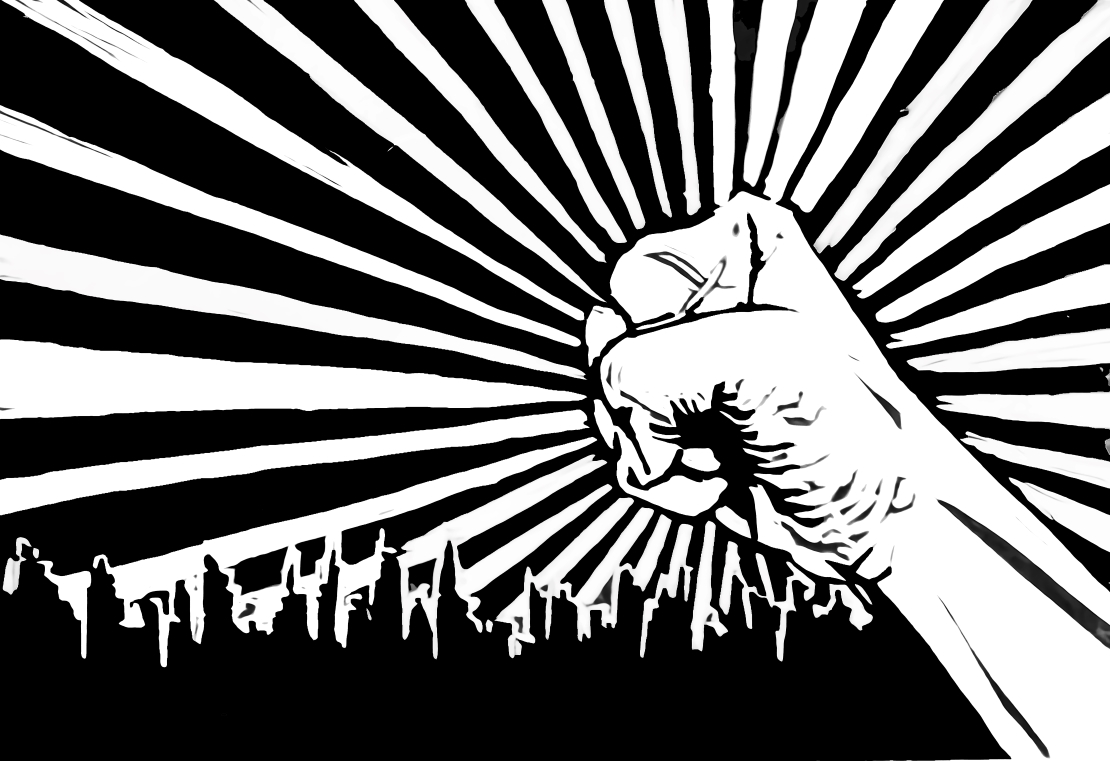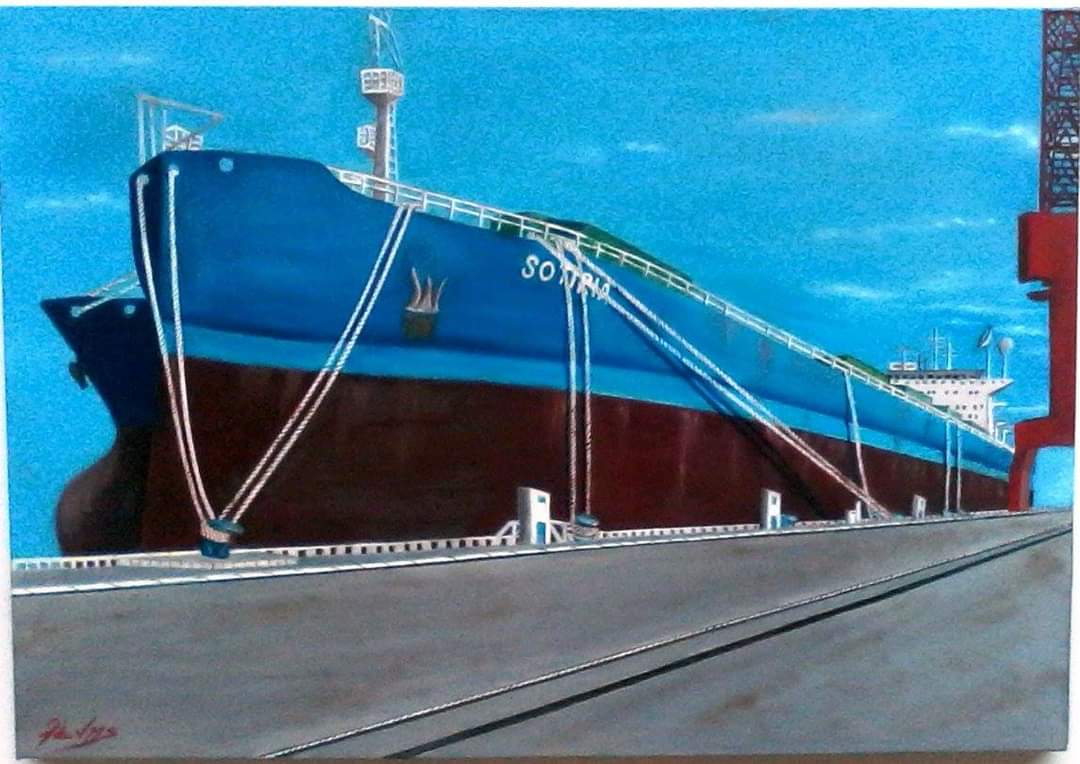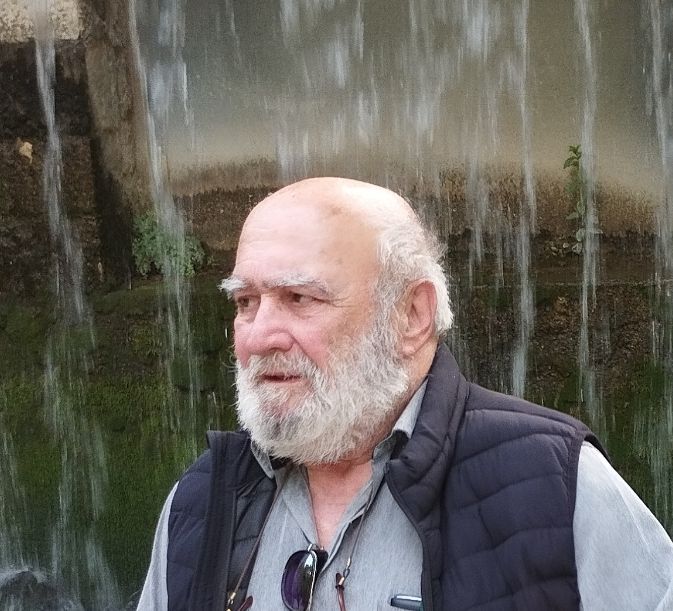 I embarked on my artistic journey later in life. It all began when I found myself attending a workshop with esteemed teachers such as Takis Schinas, Giouli Gikopoulou, Nikolas Klironomos, and Flora Diamanti on ceramics. Initially, I experimented with pencils, charcoal, oil pastels, dry pastels, oil paints, and palette knives. Later, I delved into printmaking and watercolor. As I delved deeper into the world of art, it became my true calling.
I embarked on my artistic journey later in life. It all began when I found myself attending a workshop with esteemed teachers such as Takis Schinas, Giouli Gikopoulou, Nikolas Klironomos, and Flora Diamanti on ceramics. Initially, I experimented with pencils, charcoal, oil pastels, dry pastels, oil paints, and palette knives. Later, I delved into printmaking and watercolor. As I delved deeper into the world of art, it became my true calling.
Q: What is your favorite medium of expression and why?
A: I find myself using a variety of mediums. From engraving, watercolor, and stained glass to oil paints and constructing three-dimensional pieces, I explore different avenues of  expression. From the very beginning, I have been captivated by the ability of engraving to capture intricate details, shadows, and contrasts. Watercolor, on the other hand, holds a special place in my heart, as it possesses the power to evoke certain emotions. Additionally, I enjoy working with stained glass and various materials to create structures. Materials such as glass, wood, and sheet metal inspire me greatly.
expression. From the very beginning, I have been captivated by the ability of engraving to capture intricate details, shadows, and contrasts. Watercolor, on the other hand, holds a special place in my heart, as it possesses the power to evoke certain emotions. Additionally, I enjoy working with stained glass and various materials to create structures. Materials such as glass, wood, and sheet metal inspire me greatly.
Q: How has art influenced your life and the way you perceive things?
A: Art has infused my life with a sense of creativity. It has allowed me to discover new talents and connect with like-minded individuals. Looking back, the years before I immersed myself in art seem inexplicable to me now. I feel fortunate that even at a more mature age, I found my path intersecting with the world of art. Art offers liberation to all, opening the minds of those who are closed, blinded, or burdened with prejudice. Through art, we can express our thoughts, the essence of our spirit, and the depths of our soul and body. We have the ability to pour our entire being onto canvas or paper.
Q: Where are you from, and how does your background influence your work?
A: I hail from Piraeus and Salamina. The history of Salamina has greatly influenced my artistic journey. The naval battle of Salamis, in particular, has repeatedly captivated my attention, and I consistently participate in exhibitions centered around this theme in the region. Unfortunately, it seems that the historical value of the island has not received the attention it deserves from the government. Salamina could potentially become an international tourist destination. Prior to my involvement in art, I worked for years in the ship-repair zone in Perama. Consequently, this experience has become integrated into the subjects I explore in my artwork.
Q: What issues concern you, and what message do you convey through your works?
A: Many of my works revolve around themes such as ship propellers, ports, engine repairs, and ships in general. These subjects are depicted in various forms, including paintings, engravings, and three-dimensional constructions where the ship motif takes center stage. In my work, I utilize stained glass, combined with natural wood and pebbles from the sea, often sourced from a place that holds personal significance to me—the island of Tzia. However, I also draw inspiration from various other subjects, such as human relationships, emotional states, landscapes, nature, social and political realities, and personal introspection. My aim is to empower viewers to question themselves, gain new perspectives, and confront their challenges with strength and confidence.
Q: Could you share a few words about the Panhellenic Society of Speech and Art (PELT), which you have been representing as the president for several years?
Ans: The Panhellenic Society of Speech and Art (PELT) was established in 1996 and boasts a membership of over three hundred individuals. PELT engages in activities encompassing visual arts and literature. Over time, PELT has had branches in Germany, Cyprus, and Thessaloniki, with its main hub located in Athens. The society's members have received notable recognition in various exhibition competitions. In fact, last year, at the Panhellenic exhibition organized by the Parnassos Philological Association, the first and second prizes were both awarded to PELT members.
 Q: What is the inspiration behind the frequent depiction of fisted and chained hands in your works? Is there a particular project you've created that stands out?
Q: What is the inspiration behind the frequent depiction of fisted and chained hands in your works? Is there a particular project you've created that stands out?
Ans: Fisted hands symbolize the struggle for freedom and resistance against societal constraints, beliefs, and our internal barriers. To me, hands represent strength and determination to overcome the limitations that hinder us. On the other hand, chains represent the bonds that keep us captive, preventing us from fully expressing ourselves. Through these themes, I aim to inspire viewers to seek their own freedom and authenticity. It is crucial for me to portray the concepts of revolution and liberation. My personal experiences, coupled with a sense of injustice and limitation, have guided me in exploring these themes. I firmly believe that art has the power to challenge prevailing social norms, foster self-awareness and self-assurance.
Among my works, there is a particular watercolor piece on the theme of "zeibeki" that stands out to me. It may not be my magnum opus, but it left a lasting impression. The subject of a man creating on the track is intriguing, and I endeavored to convey the essence of that experience.
Q: How do you manage your time as an artist, and what role does art play in society, in your opinion?
A: As an artist, I often find myself stealing time from other areas of my life, even sacrificing sleep, to dedicate myself to my craft. I allocate a significant portion of my time to art,  striving to create an environment that facilitates my artistic pursuits. Productivity and time management are personal matters, with each artist finding their own approach. The essential aspect is to discover what works best for you.
striving to create an environment that facilitates my artistic pursuits. Productivity and time management are personal matters, with each artist finding their own approach. The essential aspect is to discover what works best for you.
In my view, art contributes to the betterment of society. Artists have always been slightly ahead of their time, possessing restless spirits. Art serves as a catalyst for progress, encouraging dialogue, introspection, and societal evolution.
Q: You embarked on your artistic journey at a later stage in life. What are your thoughts on the prevailing sense of rush in our society, and how do you envision the future of art and your own artistic path?
A: It is true that my artistic endeavors began to unfold later in life, but I have now spent several years immersed in the creative process. Personally, I find the prevalent sense of rush in our society to be devoid of meaning. As we move forward into the future, my aim is to refine and improve my work continuously. I am content with the knowledge that I have nothing to prove—my only desire is to continue exploring the mosaic of artistic expression.
Q: How do you handle criticism of your work, and how do you overcome the challenges and obstacles encountered as an artist?
A: I embrace criticism with a positive mindset. Each critique offers a fresh perspective, allowing me to uncover aspects that I might have overlooked. Criticism serves as a means of improvement. As for obstacles, I have not faced many. Time remains the primary hurdle. It is impossible to accommodate all the tasks we face today, often necessitating the theft of time from our sleep.
Q: How does maturity affect your creative process? Are there any advantages or challenges associated with your age? What is the most crucial piece of advice you would offer to a young artist embarking on their own artistic journey?
 A: Maturity does not necessarily alter my creative process, but it undeniably brings advantages. With age comes a deeper understanding, enriching one's artistic expression. To young artists beginning their own journey, my advice is simple: work, work, work.
A: Maturity does not necessarily alter my creative process, but it undeniably brings advantages. With age comes a deeper understanding, enriching one's artistic expression. To young artists beginning their own journey, my advice is simple: work, work, work.
Q: How significant is it for an artist to exhibit their work? Have you participated in exhibitions, and what have been your experiences with them?
Ans: Exhibiting one's work holds great significance for an artist. It offers an opportunity to present oneself to the public, engage in artistic dialogue, receive feedback and critiques, and establish connections with fellow artists, curators, galleries, and collectors. Interacting with others encourages the exploration of new techniques and subject matters. Moreover, engaging with the public provides fresh ideas and invaluable feedback, fostering personal growth.
I have participated in numerous exhibitions, but one that stands out in my mind is the recent "Nomadic Canvases" exhibition at NDSM FUSE in Amsterdam, held from March 12th to 22nd, 2023. It was a group exhibition, and the experience was truly memorable.
 Giorgos Lenis was born in Piraeus and graduated from Ecole Saint Paul De Lasalle. He was taught hagiography on portable icons, composition and painting. He creates works with various materials such as watercolors, pastels and oils, as well as collages, while also developing various techniques (brush-spatula), he makes artworks on metal, combining oxidized steel with the oil pastel technique and engraving works. He participated in group exhibitions in many municipalities in Greece, as well as in exhibitions in Turkey, the Netherlands and Cyprus (Municipal Gallery of Piraeus, Technopolis of the Municipality of Athens, Perama Shipyard Repair Zone "People, Color, Iron", American College, Hilton Hotel "Money Show", Ayvali of Turkey, Educational Center of Egypt etc). At the 2022 art competition of the "Parnassos" Philological Association, he was awarded the 2nd prize for his engraving work. His works are housed in private collections and public spaces. He is the president of the Panhellenic Assosiation of Literature and Art (P.E.L.T.) since 2017.
Giorgos Lenis was born in Piraeus and graduated from Ecole Saint Paul De Lasalle. He was taught hagiography on portable icons, composition and painting. He creates works with various materials such as watercolors, pastels and oils, as well as collages, while also developing various techniques (brush-spatula), he makes artworks on metal, combining oxidized steel with the oil pastel technique and engraving works. He participated in group exhibitions in many municipalities in Greece, as well as in exhibitions in Turkey, the Netherlands and Cyprus (Municipal Gallery of Piraeus, Technopolis of the Municipality of Athens, Perama Shipyard Repair Zone "People, Color, Iron", American College, Hilton Hotel "Money Show", Ayvali of Turkey, Educational Center of Egypt etc). At the 2022 art competition of the "Parnassos" Philological Association, he was awarded the 2nd prize for his engraving work. His works are housed in private collections and public spaces. He is the president of the Panhellenic Assosiation of Literature and Art (P.E.L.T.) since 2017.


